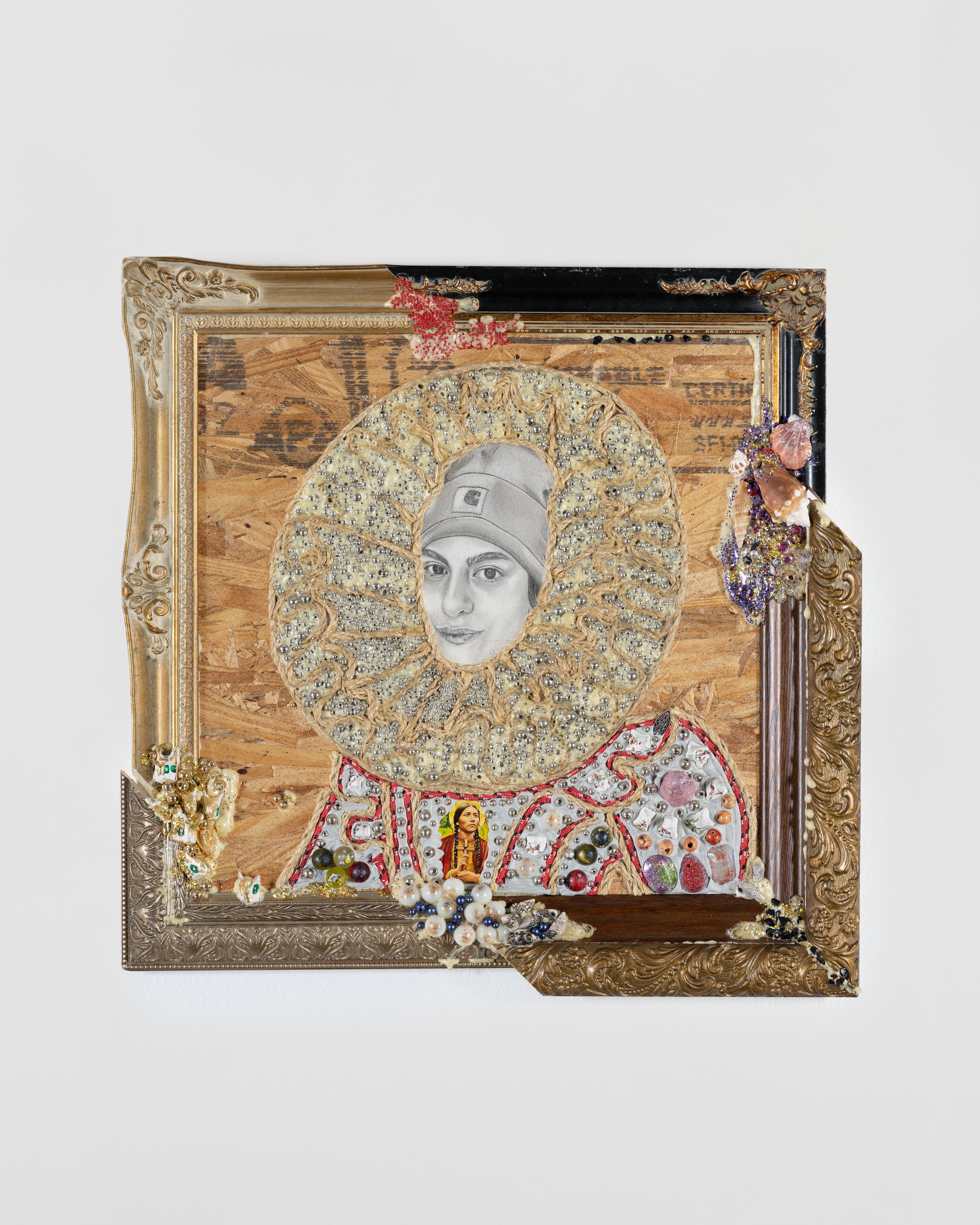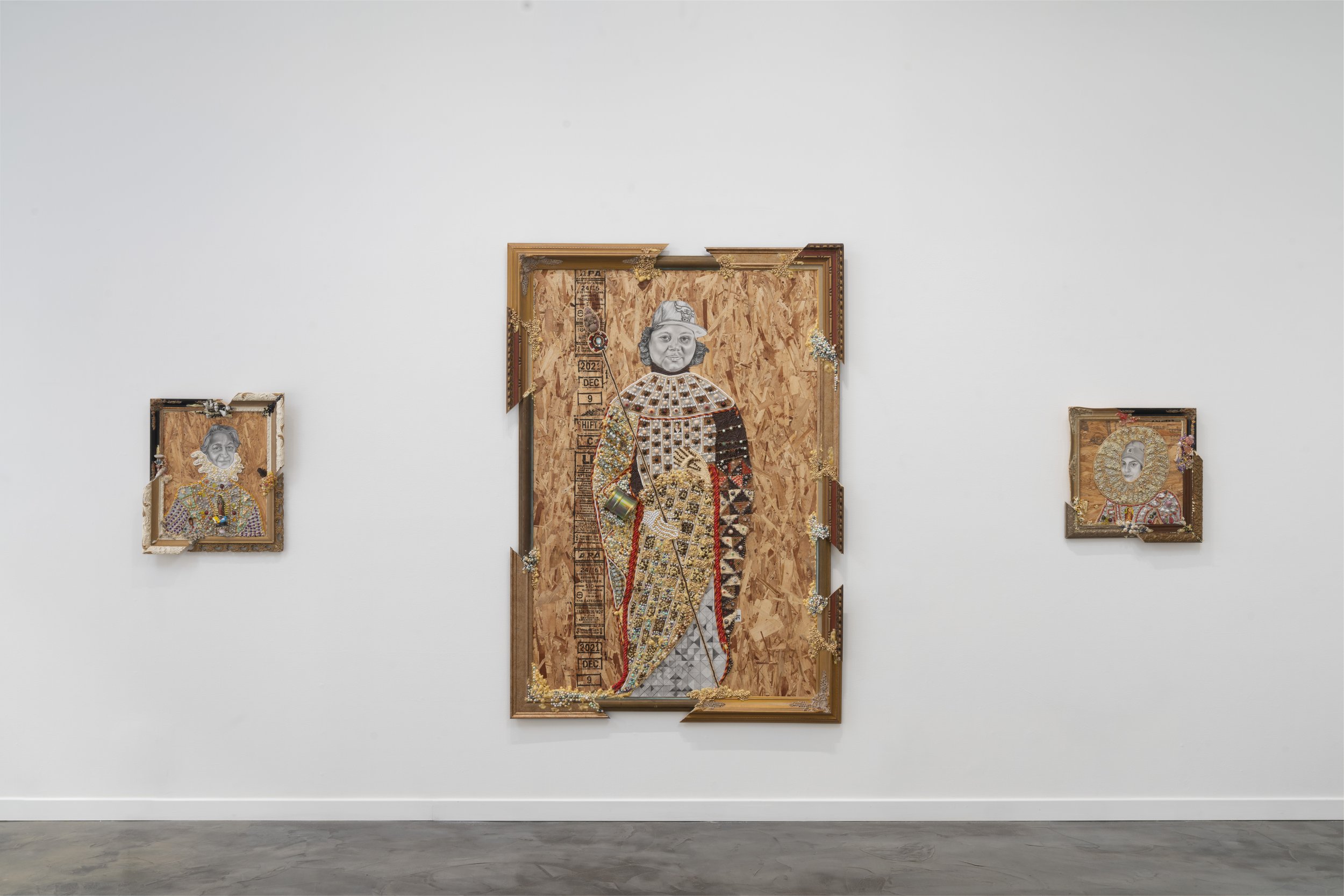Riding the Three-Headed Serpent
Riding the Three-Headed Serpent is an exhibition by Chicago-based artist Luis Alvaro Sahagun Nuño, presenting new works that interrogate how contemporary portraiture allied with Mesoamerican indigenous healing practices can serve as limpias or soul retrievals. In creating this body of work Luis worked to heal his family’s and community’s acute spiritual distress rooted in three diseases inflicted by colonization, white supremacy, and systemic oppression: Susto (soul lost or weeping soul), Bilis (rage), and Envidia (envy of the power of the oppressor).
Luis’ family portraits are rendered in charcoal and adhered to oriented strand board (OSB), a construction material made from leftover parts of knotty or crooked trees. The OSB is then layered with resin beads infused with chants, yerbas or plant medicine, sea shells, crystals, and miniature family photos. Each piece also contains small sculptures created through ritual connection with spirit guides, which allow Luis to journey into the spirit world to identify the specific animal medicine required for each sitter. The portraits or limpias become shamanic topographical maps guiding intuitive ceremonies for the release of harmful emotional energy.
Luis references and re-uses 17th century royal Spanish portraits to spotlight, celebrate, and put in positions of power stories of indigenous survival. As a means to embolden the sitter's beauty and produce grandeur, the works of art are finished with bonded together fragments of ornamental baroque-style frames.
Riding the Three-Headed Serpent explores how craft, spirituality, and labor interweave to celebrate the complexities of Latinidad/Latinx identity, immigration/migration, and decoloniality, connecting Luis’ rich ancestral history, lived experience and creative practice to intervene in this racially charged moment.



Limpia no. 1 (Maria “Mariquita” Rodriguez Sahagun)Dimensions: 56x46x4 Date: 2022
Maria “Mariquita” Rodriguez Sahagun is my sister and the middle child of our family. During this limpia we worked on mother-daughter bonds and clearing out energies that were not serving her. Near her solar plexus chakra, which is responsible for our ability to feel confident and in control of our lives, is a picture of her daughter Natalia. The image of her daughter is a reminder of her power and ability to break spells of motherhood traumas.

Title: Limpia no. 8 (Guadalupe “La Lupe” Nuño Novoa) Dimensions:28x24x3 Date: 2022
This portrait is of mi Tia Lupe, La Guadalalupana. She has a strong devotion to La Virgen de Guadalupe and uses her as a symbol for hope and miracles. The limpia performed was for clearing away energy not belonging to her while setting personal heart-felt intentions as she embarks on a new chapter in her life.


Title: Limpia no. 7 (Luis Alvaro “Huicho” Sahagun Nuño) Dimensions: 57.5x28x4 Date: 2022
Often, I think about what it means to carry different communities inside our hearts, communities as lived experiences that shape our identities. Tapping into my Nagual, my teacher in the spirit realm, I embarked on a limpia specific to one component of my identity, Huicho. Huicho invokes a specific time in my life as this nickname was given to me during my undergraduate studies. Using this identity as a means of time travel, I worked to soothe wounds inflicted via racial micro and macro aggressions during my time at a predominantly white learning institution.
Owl medicine presented itself during this work. It is a medicine for magic and courage and facilitated the pathway for resolution.

Title: Limpia no. 5 (Hector “El Tito” Chang Nuño) Dimensions: 57x28x3.5 Date: 2022
Hector Chang Nuño, my cousin El Tito, is a Chinese-Mexican born and raised in Mazatlan, Sinaloa. The port of Mazatlan, located on the Pacific coast of Mexico, is a major route for transporting goods by sea. Tito’s great-grandfather was a Chinese trader that arrived in Mazatlan and fell in love with his great-grandmother. Tito has a strong drive to learn and connect with Chinese culture. His limpia used the medicine of Dogs of Foo, lion-like creatures containing mystic powers of protection. A lion’s roar causes trembling and symbolizes wisdom, fearlessness, and pride. On his chest lies an image of the first Chinese Orthodox priest, St. Mitrophan of China, patron of lost children, for protection and guidance .

Limpia no. 6 (Hector “El Hugo” Gonzalez Nuño) Dimensions: 57.5x28x4 Date: 2022
Mexicanos al Grito de Guerra is tattooed across my cousin Hugo’s chest. Possessing a restless and warrior heart, Hugo’s medicine showed up as a horse and a shapeshifting dog in the form of a wolf. Horse medicine teaches us how to ride in new directions and awakens our freedom. Dogs are known for their playfulness and loyalty and in Meixca culture Xolotl is the dog-faced god of fire and lighting. Wolves are nocturnal and territorial creatures and their howl is a grito, a scream to notify the pack of danger. Wolf and horse provide wisdom for discerning who to give loyalty to and connecting us to true freedom.

Title: Limpia no. 11 (Katya Flores Sahagun) Dimensions: 24x24x2 Date: 2022
Katya Flores Sahagun is my cousin and the only family member represented in this series of limpias from my paternal side of the family. The image of Saint Kateri Tekakwitha, the first Native American saint, rests on her chest. This controversial symbol is open for interpretation as many celebrate her sainthood while others shun her religious conversion, reflecting the inner conflicts left by the residue of colonization.


Limpia no. 10 (Arturo, “El Trompas” Ibarra Nuño) Dimensions: 34x34x4 Date: 2022
For my cousin Arturo’s portrait, I called upon St. Judas, the patron of desperate and lost causes, inverting his saintly image on Arturo’s chest. Unicorns flank the saint for their medicine in showing us the magic in the world and helping us view life through the lens of an innocent child. In the sacred direction of the West, a place of reflection, gratitude, and accomplishment, lies the statue of liberty, to some a false symbol of freedom. Here it is used as a tool for processing Arturo’s experiences as an immigrant in this country.

Title: Limpia no. 4 (Tatiana “La Taty” Gonzalez Nuño ) Dimensions: 57x57x4.5 Date: 2022
Tatiana Gonzalez Nuño, La Taty, is my cousin from my mother’s side of the family. Born and raised in Mazatlan, Sinaloa, she is a trained and gifted makeup artist with a rebellious soul. During her limpia, I received barn swallow and tiger medicine. Barn swallows, although small, are outspoken and forceful. For many indigeneous cultures these birds are known to be mighty and wake people up from their sleep. The image of the tiger has the ability to embolden ambition as they are synonymous with drive, strength, and courage. Their black stripes are sharp slices of darkness and represent the ability to cut through the darkness of life to pursue healing and trust.

Title: Soul Retrieval no. 3 (Luis Alvaro “Alvarito” Sahagún Nuño) Dimensions: 30x15x2 Date: 2022
I created this self-portrait as a soul retrieval for deeply connecting with lost components of my wounded inner child, Alvarito. Alvarito lives inside me, a ten year old playful, adventurous, and innocent child who mentors me on living my present life with joy and laughter. I was born on the day of the warrior of Tezcatlipoca, the smoking mirror, jaguar deity, and god of ancestral memory. His image as a jaguar is represented on my hat, which is slightly tilted toward the sacred direction of the South, the place of child innocence, expansion, and raw fighting energy.

Barrida no.2 (Gloria Eloisa “Lothita” Nuño Novoa & Maria “toñita” Nuño) Dimensions: 90x56x4 Date: 2022
A barrida in Curanderismo is an energetic sweeping, a way to purify and revitalize an individual for renewal. Sweeping rites also serve as offerings to the divine. For this piece, I wanted to sweep away unhealthy energies while creating a stronger bond between my grandmother Lochita and my mother Toñita. The portrait is that of my grandmother holding my mother when she was a baby, my version of Madonna and child.
While I was working on this portrait in the studio, I bent down to get rope and there laying next to it was a four foot serpent. It had entered my studio and found refuge by camouflaging itself among my rope. I believe it was an omen or visit by Coatlicue, mother of gods, depicted with a fanged serpent face and wearing a skirt similar to the one in this piece, which I was working on at the time.



